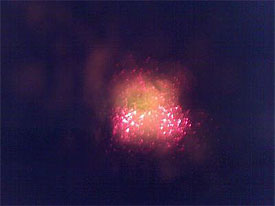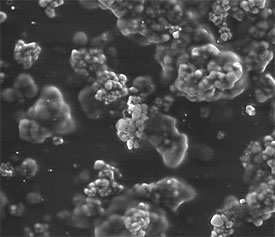SALT LAKE CITY, Jan. 25, 2010 – When University of Utah scientists discovered a new kind of laser that was generated by an electrically conducting plastic or polymer, no one could explain how it worked, and some doubted it was real. Now, a decade later, the researchers have found that these "random lasers" occur because of natural, mirrorlike cavities in the polymers, and they say such lasers may prove useful for diagnosing cancer.
"Nobody knew how it worked until now," said Z. Valy Vardeny, a distinguished professor of physics and senior author of the new study. "We succeeded in imaging the cavities. This is a big step in our understanding of this bizarre phenomenon, which not many people believed."
Materials or "gain media" that generate conventional lasers are put in an ordered structure known as "lossless resonators" – often mirrors – that generate light without losing much of it. Random laser materials, in contrast, are disordered and lose some light.

This microscope image shows a portion of a piece of an electrically conducting plastic or polymer film that has been bombarded by a pulse of green light from a conventional laser. The green light excites tiny cavities within the film to produce red-colored "random laser" light seen in the photo. University of Utah physicists have published a study explaining how this bizarre kind of laser works. (Images: Randy Polson, University of Utah)
Or, as Vardeny put it: "You can get lasing out of junky materials if they contain molecules that glow. Out of disorder comes perfect order."
In the new study, Vardeny and colleagues created images to reveal the natural cavities within a "pi-conjugated polymer film," which is a thin film of an organic polymer – named DOO-PPV – that conducts electricity even though it is a plasticlike material. ("Pi-conjugated" refers to the material's electronic structure.)
The microscopic cavities – natural irregularities within the plastic – act together like the mirrors in regular resonators that help amplify the light in a conventional laser.
Lasers "are carefully designed and constructed to produce laser emission," said study co-author Randy Polson, a senior optical engineer at the university's Dixon Laser Institute. "Surprisingly, there is a class of lasers where laser emission happens from materials that are literally shaken together. These are called random lasers, since the emission happens from an uncontrolled configuration" – a disordered rather than crystal structure within the "lasing medium" – the material used to generate the laser.
"There has been some disagreement as to how random lasers operate. For an analogy, imagine you are outside a sports stadium and hear the roar of the crowd. Is the noise initiated throughout the stadium at the same time (led by cheerleaders shouting 'Go! Go!'), or are people yelling on their own ('Great catch!' 'Yea!')?"
"Our work has shown that the emission from random lasers happens with one emitter at a time, like individuals in the crowd yelling unconnected shouts," Polson said.
Vardeny and Polson conducted the study with first author Abdullah Tulek, who now works in Turkey but was a University of Utah doctoral student at the time. The study was funded by the US Department of Energy and by the National Science Foundation.
How Lasers Work
Laser stands for light amplification by stimulated emission of radiation. Unlike a bulb, which emits many wavelengths of light in all directions, conventional laser light has one wavelength and moves as a beam in one direction with light waves in lockstep.

This microscope view of a film of the polymer DOO-PPV shows clumps of undissolved polymer power within the darker dissolved polymer material. Such irregularities are believed to create the tiny cavities that act as built-in, mirrorlike resonators to produce what is known as "random laser" light, according to a new university study.
In explaining how a laser beam is emitted, Vardeny said that first "you excite a molecule or a chromophore" – a dye or other substance that emits light – using electricity or another source of light. The excited molecule emits a photon or light particle. The photons travel and stimulate other chromophore molecules to emit additional light.
When a bunch of photons hit chromophores with the right energy to be in resonance with the light the chromophores will emit, the chromophores emit light at the same instant they are hit by the photons. The combined emission is stimulated emission of radiation – the "ser" in laser.
As lasers were developed in the 1960s, researchers realized that if you put more chromophores together in a cavity in some crystalline material, the optical cavity would act like a mirror, amplifying (the "a" in laser) the stimulated emission of light.
Vardeny said most conventional lasers fall into two categories of laser action:
•Cavity lasers, such as those in laser pointers and grocery scanners. In these lasers, the laser-generating material is contained within the cavities.
•Lasers that do not require cavities, just a polymer made of a chain of chromophores that emit light in rapid-fire sequence, amplifying the light output. Pulsed lasers used commercially and in medicine use this method.
Two other kinds of lasers have been demonstrated but not used for practical purposes: superradiance and superfluorescence lasers, in which chromophores "feel" each other to act in concert and produce laser light without mirrors.
Pi-conjugated polymers luminesce when excited by electricity or a light source. They emit various colors and are used to make light-emitting diodes (LEDs) that are increasingly common in everything from traffic signals to Christmas lights.
In 1999, Vardeny and colleagues published in the journal Physical Review B their discovery of a fifth kind of laser – the random laser. In a film of the polymer DOO-PPV, they produced laser light of multiple wavelengths within a narrow band of red.
It appeared to be a cavity laser because of the nature of its light emissions – except no one could find cavities in the polymer film.
Physicists "couldn't understand it," Vardeny said. "Nobody really understood it."
Yet other groups of researchers soon found random lasing in other materials.
The New Study: Order Within a Disordered Material
In conventional lasers, cavities are created by carefully placing mirrors around the medium that contains the chromophore material, be it a crystal, gas or dye, Vardeny said. The new study shows random lasers have tiny, built-in, natural mirrors, he added. To make pictures of laser-generating cavities within the DOO-PPV polymer, the scientists focused a green, conventional laser pulse on a thin film of the polymer, stimulating red random laser emission from the film. By focusing a lens in a certain way, they made 10,000 images of the red laser light spectrum emitted by microscopic squares within the film, then assembled them into an image of the entire piece of polymer film.
They revealed the mirrorlike cavities by showing adjacent pixels with the same red light spectrum and the same above-average index of refraction, which is a measure of how fast light travels within a material. When they mapped areas of above-average refraction index within the DOO-PPV polymer, those areas were connected to form loops, which act as mirrorlike cavities to generate laser light, Vardeny said.
The Utah researchers used what is known as a "Fourier transform" to analyze the wave pattern from the DOO-PPV random laser. Polson cited an analogy: If you strum a guitar, and then use a Fourier transform to analyze the sound waves, you can figure out what strings or notes were played at any moment.
In a similar manner, the researchers transformed the light wave patterns for various spots on the polymer, revealing that there were cavities within the material.
Random Lasing Could Automate Tissue Analysis for Cancer
Vardeny and his colleagues now are conducting more research aimed at developing and commercializing random lasers to distinguish cancerous from noncancerous human tissue. In a 2004 study in Applied Physics Letters, they infused human colon tissue – normal and tumor – with a red fluorescent dye that generates random laser light when stimulated.
They could distinguish tumor from normal colon tissue because the tumor emitted more individual lines of random laser light, possibly because its structure was more disordered than normal tissue.
"The disorder in cancerous tissue is much more chaotic than that in a benign tissue," Vardeny said.
Pathologists now look for abnormalities that indicate cancer, but Vardeny said the random lasing method has potential for automating tissue examinations for cancer.
This work was published online in the journal Nature Physics.
For more information, visit: www.utah.edu